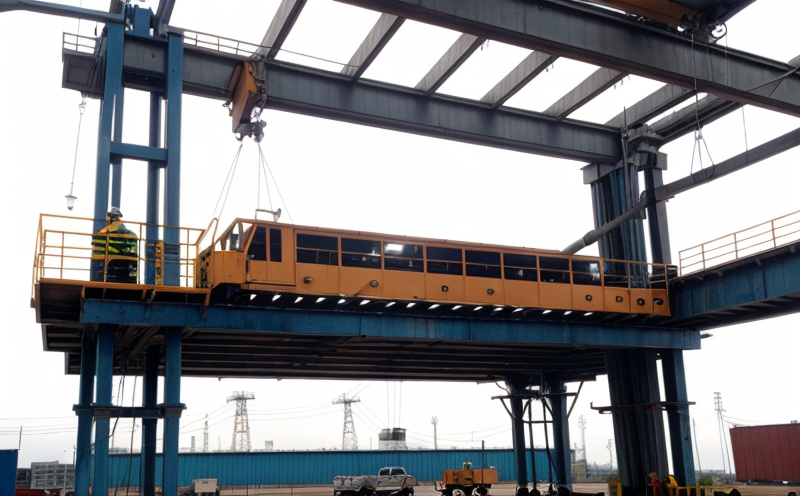Lifting beam inspection
The integrity and reliability of lifting beams are paramount in industries where heavy loads are frequently moved. Lifting beams, often fabricated from steel or other robust materials, play a critical role in ensuring the safety and efficiency of material handling operations. These structures must withstand significant forces without compromising their structural integrity. Thus, regular inspections using precise methods are essential to prevent failures that could lead to serious accidents.
Inspecting lifting beams involves a series of detailed checks aimed at identifying any signs of wear, corrosion, or deformation. The inspection process typically begins with visual assessments conducted by experienced technicians who look for visible cracks, dents, or other anomalies on the surface of the beam. This initial examination provides valuable insights into the overall condition and durability of the lifting beam.
Following a visual assessment, non-destructive testing (NDT) techniques are employed to detect internal defects that might not be apparent during a simple inspection. Common NDT methods used in lifting beam inspections include ultrasonic testing, magnetic particle inspection, and radiographic examination. Each method has its own strengths and is chosen based on the specific requirements of the application.
Ultrasonic testing uses high-frequency sound waves to detect internal flaws within the material. Magnetic particle inspection relies on the principle that defects in ferromagnetic materials can attract magnetic particles applied to their surface, highlighting areas where anomalies may exist. Radiographic examination involves exposing the beam to radiation and analyzing the resulting images for signs of internal damage or structural weakness.
Once the inspection is complete, the results are carefully evaluated against industry standards and best practices. Acceptance criteria vary depending on factors such as the material type, load capacity, and environmental conditions under which the lifting beam operates. Compliance with these standards ensures that the lifting beam remains safe for continued use.
The importance of lifting beam inspections cannot be overstated, particularly in sectors like construction, manufacturing, and logistics where heavy machinery is frequently used. Regular inspections help prevent accidents, reduce downtime, and extend the lifespan of critical equipment. By adhering to rigorous inspection protocols, organizations can maintain high levels of safety and operational efficiency.
Why It Matters
The reliability and integrity of lifting beams directly impact workplace safety and operational efficiency in various industries. Accidents involving heavy load handling can lead to severe injuries or fatalities, making it essential to ensure that lifting beams are in optimal condition at all times.
- Enhanced Safety: Regular inspections help identify potential hazards before they escalate into accidents, thereby safeguarding workers and equipment.
- Avoidance of Downtime: Preventive maintenance through periodic inspections reduces the risk of unexpected failures that could cause extended downtime.
- Cost Efficiency: By catching issues early, organizations can avoid costly repairs or replacements down the line. Regular inspections also help in optimizing resource allocation and reducing waste.
In industries like construction and manufacturing, where heavy lifting is a routine activity, the importance of lifting beam inspections cannot be understated. These inspections contribute significantly to maintaining high standards of safety and operational excellence.
Applied Standards
The inspection of lifting beams adheres to several international standards that ensure consistency and reliability across different regions. One such standard is ISO 3089, which provides guidelines for the design, manufacture, inspection, and maintenance of lifting appliances. This standard emphasizes the importance of regular inspections and specifies acceptable limits for various defects.
Another relevant standard is EN 14470, which addresses the requirements for wire rope slings used in lifting operations. While this standard primarily focuses on wire ropes, it also includes recommendations for inspecting components that interact with these slings, such as lifting beams.
In addition to ISO and EN standards, organizations may refer to ASTM E681-13, which provides specifications for the visual inspection of new and used steel chain slings. Although this standard is more specific to chain slings, it offers valuable insights into best practices for inspecting components that are part of a lifting system.
These standards collectively provide a framework for ensuring that lifting beams meet the necessary safety and quality requirements. Compliance with these guidelines helps organizations maintain high levels of operational efficiency while minimizing risks associated with heavy load handling.
Why Choose This Test
- Precision: Using advanced non-destructive testing techniques, lifting beam inspections ensure that internal defects are identified accurately and reliably.
- Expertise: Our team of highly skilled technicians has extensive experience in conducting comprehensive inspections tailored to the specific needs of each client.
- Compliance: By adhering strictly to international standards, we guarantee that our inspections meet all regulatory requirements, providing peace of mind for your organization.
- Reliability: Regular inspections enhance the reliability and longevity of lifting beams, ensuring they continue to perform at their peak capacity.
The precision and expertise provided by our team make us a trusted partner for organizations seeking reliable lifting beam inspection services. Our commitment to compliance and reliability ensures that your critical equipment remains safe and efficient throughout its operational life.





